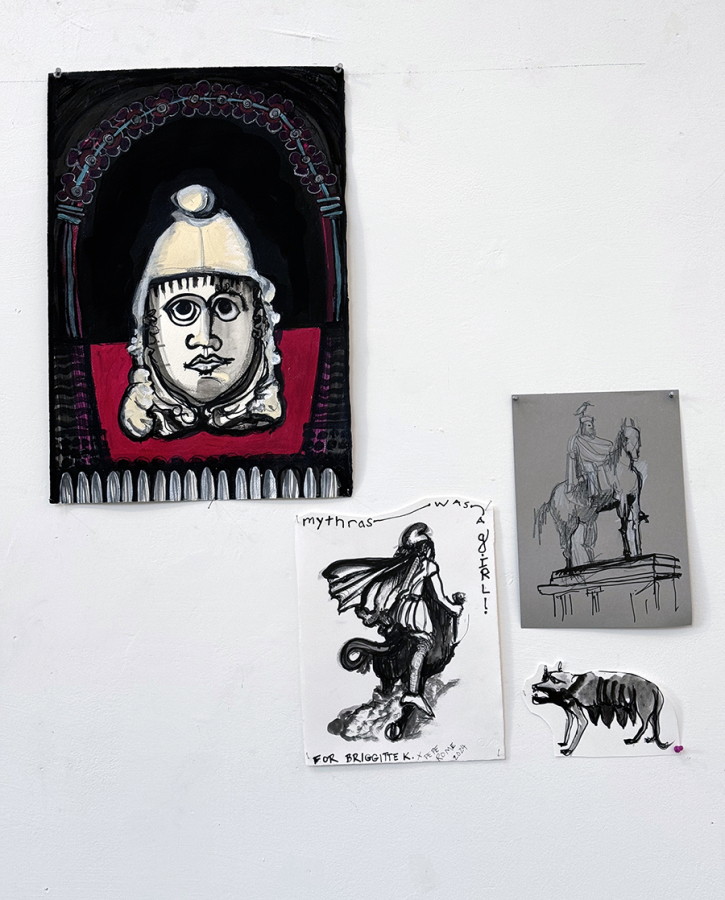The Brooklyn-based artist Sheila Pepe arrived in Rome last fall as the 2025 Henry W. and Marian T. Mitchell Rome Prize Fellow, where she pursued a sculptural inquiry titled It’s All Public. Known for work that spans postminimalism, queer abstraction, and figuration, Pepe has turned her attention to the charged arena of public art—a shift sparked by her 2023 commission My Neighbor’s Garden in Madison Square Park. In Rome, she reconsidered traditional sculptural materials and forms, from Etruscan bronze to Baroque stone, while engaging critically with the nationalist legacies of neoclassical sculpture in both Italy and the United States.
The Academy recently checked in with Pepe, who returned to the US in January following her half-term fellowship.
What did you work on while at AAR?
First, it’s important to say that each day at the Academy brimmed with a happiness that came from the beautiful daily care provided by the staff, by the talent, brilliance, and engagement of my colleagues, and by the singular responsibility to tend to my own work. It was a rare state and experienced so seldom. I saw and felt the huge turn in my work that could last the next twenty years.
Did your project change after arriving?
Yes, and no. I kept my eyes on the issue of public art, its history and purposes. Being in Rome provided exactly what I thought it would: an embodied perception of the collapsed time that the city holds in its constructions. Living and working on the Gianicolo brought to me the fullness of risorgimento monuments, both lasting and ephemeral. The latter was expressed every day at noon with a cannon’s boom nearby. This kind of martial fabric reinforced the patria that’s heard in, say, the Italian national anthem that I listened to before arriving last September. I discovered, surprisingly, that this sensibility was not only antique, and neither were the horse-mounted men on Capitoline Hill. Thankfully I found an antidote through my hall neighbor, the writer Selby Wynn Schwartz. Fluent in Italian, she stays up to date with the events of, for example, the local transfeminist movement. I found her translations and descriptions extremely hopeful.

In all, my time with the writers and scholars was completely transformational. As a sculptor, I am sensitive to constructed space, proximity, and planned adjacencies, so I felt the beneficial planning of the Academy’s Residential Life team. Selby to my right, the writer Jacob Shores-Argüello’s office/studio around the corner, and the brilliant art historian PhD candidate Shannah Rose across the hall. Jacob is a natural teacher, even with his peers; his ability to mine any topic, including the nature of “writer’s mind” now feeds my Brooklyn studio. Shannah and I will share New York City when she returns and continue a mutual love each other’s pursuits.
That’s not to mention the other fellows! For example, working with Brigitte Keslinke on our shoptalk was a thrill—and also grounding. Brigitte and I share the primary understanding that human-made things hold intelligence. We both know and use our ability to “read” these things in multiple contexts now, and within our long histories. I found this idea shared so vibrantly among all the scholars, even when the “things” were words. For example, during a discussion at dinner, Emily Mitchell noted that term transfeminist is best understood using the Latin sense of “trans” (across, over, beyond), which opens twenty-first-century feminism to a much-needed multiplicity of meanings. Think transnational, transcendent, and transcribe. My American English–thinking brain was blown, and that was just one dinner.
What was your most surprising discovery?
I spent a lot of time on the hill, in part because a bad heel spur kept my walking to targeted trips to historic sites and museum collections. But also, and because of, the beautiful patterns of existence created by Academy staff and residents. All this provided a living Rome that replicated some aspects of my youth working inside a family deli and lunch counter, and years later creating in my own studio in Brooklyn. There was so much care and pride apparent in the staff’s work, all done in service of others. Every kind of physical and intellectual work filled the building; the staff’s activities that I could see seemed so beautifully paired with the mostly unseen work of fellows in their studios and offices. In this milieu my work proceeded in an ideal fashion and pace, judgement held until I might understand what ideas it will support and convey in the coming months.
What is coming up in the next few months?
I planned every day after the eleventh of January, the day I landed at JFK following my fellowship, to be as busy as possible, so that I wouldn’t miss the pace and luxury of my life in Rome. Now with much of that done, and shows now opening, and other exhibitions planned for the summer and fall, I’ll return to Rome with my wife, the painter Carrie Moyer, in late April to celebrate my modest participation in an exhibition at the Keats-Shelley House. And, days before that, we’ll attend the first Dyke March in Rome.